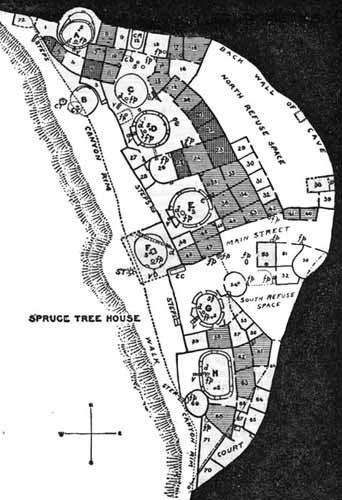
With 130 rooms and 8 kivas, 60 - 90 people lived here. It is the third largest cliff dwelling and was constructed between 1211 and 1278.

A drawing of Spruce Tree House. It is autumn, the busiest time of year. The harvest is underway and people are spreading the crops on the rooftops to dry.




The steep, but fully paved, path down

This is how kivas used to look... completely roofed over.

Going down inside!

The heavy beams were supported on the brick posts.

The ventilator and air deflector. It was definitely cozy down here.

Heading back out




The top left and bottom right T-shaped doorways seem to have been filled up.




Grinding stones together wish some shards of painted pottery



He's just way too sexy for this rock.
We opted out of doing any more of the walking trails and just did the Mesa Top Loop drive with its easy stops. It had started to rain again a bit and we still had so much left to see.
The Mesa Top Loop drive involved many stops: Pithouse, Navajo Canyon Overlook, Square Tower House Overlook, Mesa Top Sites, Pithouse and Pueblos, Sun Point Pueblo, Sun Point View, Oak Tree House, Fire Temple and New Fire House, and finally Sun Temple.
Pithouse - It sometimes quite difficult to make the jump from random holes and scattered stones to picturing what life would have been like here in the year 600. It was not just some random design since it was repeated in many locations. The holes in the four corners were probably for posts that supported a ceiling. The entrance was probably located above the fire pit.

Bits of fire-hardened adobe and charcoal rubble on the floor are clues that this dwelling burned.

The small room in the back, the antechamber, may have been used as storage for the harvest.

Storage pits were used to hold different things. They were lined with slabs of rock, then covered with logs and flat stones.
Navajo Canyon Overlook - Surrounded by these deep canyons, the villages here seem to be so isolated, cut off from people on the other mesas. But actually the cliffs are covered with hand and toe trails. These steep, vertical climbs were part of their daily routine. There is also strong evidence of cooperation and exchange. The culture could not have developed so rapidly in isolation.
Square Tower House Overlook - Occupied from 1200 - 1300, the four-story tower was the tallest man-made structure in the US until the mid-1800s... at 86 feet high.

